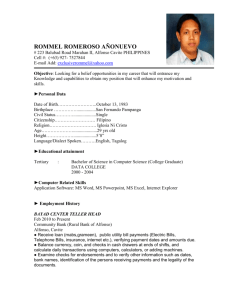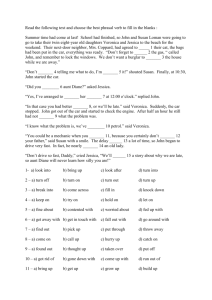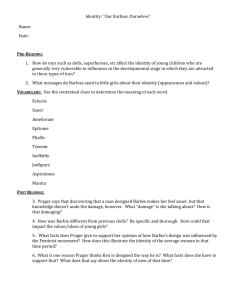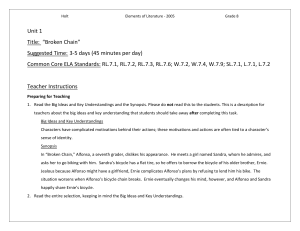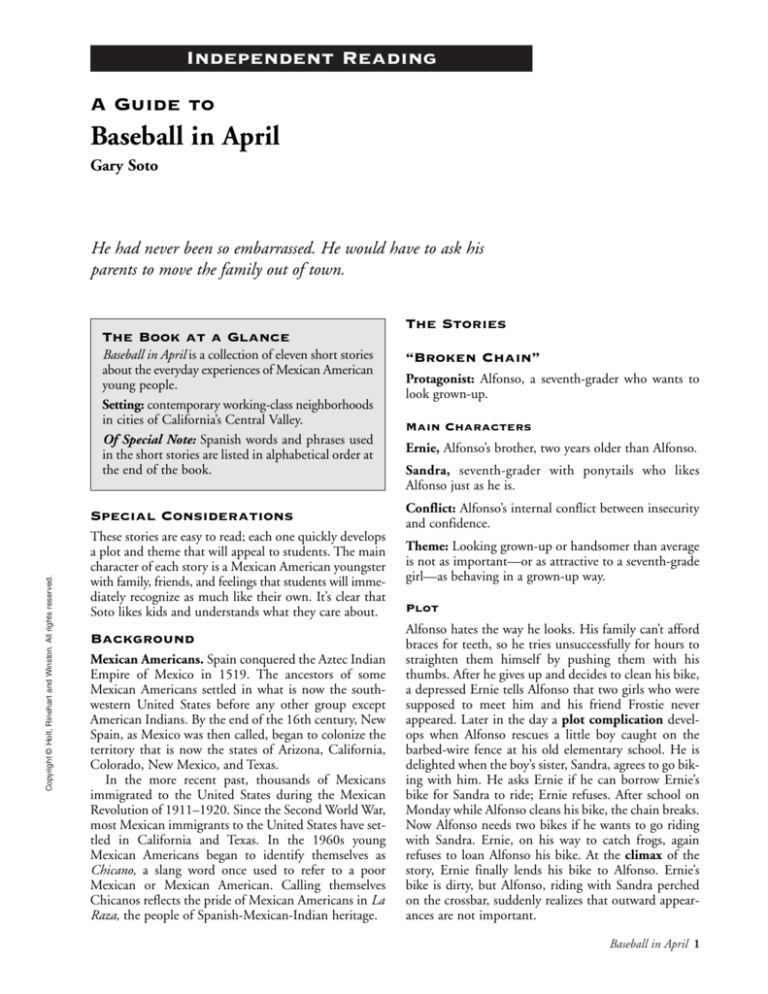
Independent Reading
A Guide to
Baseball in April
Gary Soto
He had never been so embarrassed. He would have to ask his
parents to move the family out of town.
The Stories
The Book at a Glance
Baseball in April is a collection of eleven short stories
about the everyday experiences of Mexican American
young people.
Setting: contemporary working-class neighborhoods
in cities of California’s Central Valley.
Of Special Note: Spanish words and phrases used
in the short stories are listed in alphabetical order at
the end of the book.
Copyright © Holt, Rinehart and Winston. All rights reserved.
Special Considerations
These stories are easy to read; each one quickly develops
a plot and theme that will appeal to students. The main
character of each story is a Mexican American youngster
with family, friends, and feelings that students will immediately recognize as much like their own. It’s clear that
Soto likes kids and understands what they care about.
Background
Mexican Americans. Spain conquered the Aztec Indian
Empire of Mexico in 1519. The ancestors of some
Mexican Americans settled in what is now the southwestern United States before any other group except
American Indians. By the end of the 16th century, New
Spain, as Mexico was then called, began to colonize the
territory that is now the states of Arizona, California,
Colorado, New Mexico, and Texas.
In the more recent past, thousands of Mexicans
immigrated to the United States during the Mexican
Revolution of 1911–1920. Since the Second World War,
most Mexican immigrants to the United States have settled in California and Texas. In the 1960s young
Mexican Americans began to identify themselves as
Chicano, a slang word once used to refer to a poor
Mexican or Mexican American. Calling themselves
Chicanos reflects the pride of Mexican Americans in La
Raza, the people of Spanish-Mexican-Indian heritage.
“Broken Chain”
Protagonist: Alfonso, a seventh-grader who wants to
look grown-up.
Main Characters
Ernie, Alfonso’s brother, two years older than Alfonso.
Sandra, seventh-grader with ponytails who likes
Alfonso just as he is.
Conflict: Alfonso’s internal conflict between insecurity
and confidence.
Theme: Looking grown-up or handsomer than average
is not as important—or as attractive to a seventh-grade
girl—as behaving in a grown-up way.
Plot
Alfonso hates the way he looks. His family can’t afford
braces for teeth, so he tries unsuccessfully for hours to
straighten them himself by pushing them with his
thumbs. After he gives up and decides to clean his bike,
a depressed Ernie tells Alfonso that two girls who were
supposed to meet him and his friend Frostie never
appeared. Later in the day a plot complication develops when Alfonso rescues a little boy caught on the
barbed-wire fence at his old elementary school. He is
delighted when the boy’s sister, Sandra, agrees to go biking with him. He asks Ernie if he can borrow Ernie’s
bike for Sandra to ride; Ernie refuses. After school on
Monday while Alfonso cleans his bike, the chain breaks.
Now Alfonso needs two bikes if he wants to go riding
with Sandra. Ernie, on his way to catch frogs, again
refuses to loan Alfonso his bike. At the climax of the
story, Ernie finally lends his bike to Alfonso. Ernie’s
bike is dirty, but Alfonso, riding with Sandra perched
on the crossbar, suddenly realizes that outward appearances are not important.
Baseball in April 1
“Baseball in April”
“Barbie”
Protagonists: Michael and Jesse are brothers who love
to play baseball. Michael is eleven, Jesse is nine.
Protagonist: Veronica Solis, a young girl who loves
Barbie dolls.
Conflict: The brothers’ external conflict between their
dismal baseball skills and their intense desire to play on
a team.
Main Characters
Rudy, Veronica’s uncle; he gives her two dolls: an “imitation” Barbie and a real Barbie.
Theme: Being part of a team and having fun is more
important than winning.
Donna, Rudy’s girlfriend.
Plot
Martha, Veronica’s friend; she has two Barbies and one
Ken doll.
“Two Dreamers”
Protagonists: Hector Molina, a quiet, nine-year-old
boy, and Luis Molina, Hector’s grandfather, a night
watchman who dreams of retiring a wealthy man.
Conflict: Luis’s external conflict between wanting to
buy real estate and not having the money to invest.
Theme: Love between a grandson and grandfather is
built on the dreams and trust they share.
Plot
Hector’s grandfather Luis hears that his son-in-law
made a lot of money by buying a house and reselling it.
Luis thinks he might like to fund his retirement by
making money in real estate. His wife thinks this is a
crazy idea since they already have a house and don’t
have money to buy another one. Hector and Luis see a
house with a “For Sale” sign. Luis offers Hector two
dollars to act as his interpreter in two calls to the real
estate agent. The agent overwhelms Hector with information about the house and finally tells him the price,
which is much too high for his grandfather. His grandfather fears that his wife will find out he has been “pretending to be a big shot.” While Hector is on the phone
with the agent, his grandmother calls out to see what
her two “locos” are doing, and a nervous Luis hangs up
the phone. In the story’s climax Luis promises to give
Hector four dollars if Hector saves him from his wife’s
scolding. Hector tells his grandmother that he was calling a friend, and Grandfather corroborates the lie. Luis
gives Hector two dollars and promises to give his grandson the rest when he becomes rich.
2 Baseball in April
Conflict: Veronica’s internal conflict between adoring a
doll completely unlike herself and loving a doll who
looks like her.
Theme: Prettiest is not always best.
Plot
Veronica desperately wants a Barbie doll like the ones
she sees advertised on television. She is bitterly disappointed when her uncle Rudy gives her a black-haired
imitation Barbie for Christmas. She thinks this doll is
ugly and throws it against the wall. The following year,
Rudy brings his fiancée, the blond, blue-eyed Donna,
to meet the family. The two give Veronica a Barbie doll
with three Barbie outfits. Later, when Veronica and
Martha play together at Martha’s house, Martha tries to
switch Barbies so that she can have Veronica’s newer
doll. In the story’s climax Veronica is devastated when
she discovers that Barbie has somehow lost her head on
the trip home. Martha helps Veronica search, but the
girls cannot find the head. A distraught Veronica yells
at Martha, and her friend runs home. That night a
calmer Veronica lovingly takes both poor, headless
Barbie and black-haired, fake Barbie to bed.
“The No-Guitar Blues”
Protagonist: Fausto, a teenager who wants to be a rock
musician.
Conflict: Fausto’s internal conflict between his longing
to keep the reward money and his feelings of guilt
about tricking Roger’s kind owners.
Theme: Dishonesty brings only guilt; honesty is often
rewarded.
Plot
Fausto wants a guitar so he can become a rock musician. When his mother tells him a guitar costs too
much, he tries to earn the money to buy one. He finds
a dog named Roger with an address on its collar. He
takes the dog to its owners and lies about where he
found it, saying it was way over by the freeway. Roger’s
owners give Fausto a twenty-dollar reward. That’s
enough to buy a secondhand guitar, but Fausto, torn by
guilt, goes to church and, in the climax of the story,
drops the money into the collection basket. The next
Copyright © Holt, Rinehart and Winston. All rights reserved.
Michael and Jesse try out for Little League, but the
coaches seem uninterested even though the brothers do
their best. Neither boy makes a Little League team. A
friend tells the brothers about a team that practices near
Hobo Park. The enthusiastic coach of the Hobos lets
anyone play. Michael quits the Hobos when he finds a
girlfriend, but Jesse continues to play all summer,
although his batting doesn’t improve. At the story’s climax Jesse finally gets on base when the pitcher throws
a ball that hits his leg. When baseball season is over,
Jesse remembers the fun he had playing on a team—
even though he knows he didn’t play well.
Helen Solis, Veronica’s mother, Rudy’s sister.
day, his mother remembers seeing her father’s guitarron
when she cleaned out his garage. Grandfather Lupe
gives the guitarron to Fausto, who is confident that this
is the beginning of a successful musical career.
Moreno cries. The next day, after Ernie calls Yollie to
ask for a date, Mrs. Moreno takes some of the money
she has been saving, and mother and daughter buy a
new outfit that will withstand any weather.
“Seventh Grade”
“The Karate Kid”
Protagonist: Victor Rodriguez, a seventh-grader who
has a crush on a classmate named Teresa.
Protagonist: Gilbert Sanchez, a quiet and studious
fifth-grader.
Conflict: Victor’s internal conflict between fear of
embarrassment and his desire to impress Teresa.
Conflict: Gilbert’s internal conflict between his movie
image of self-defense and the reality of learning to
defend himself.
Theme: Sometimes even the most hopeless situation
turns out well in the end.
Plot
Victor signs up for French because he hopes Teresa will
be in his class. In a gently humorous characterization
of seventh-grade boys, Victor’s friend Michael practices
scowling because he thinks having the same look as the
models in GQ will attract girls. Victor himself resorts to
scowling when his attempts at conversation with Teresa
fall flat. In French class Victor is so eager to impress
Teresa that he raises his hand when the teacher asks if
anyone knows French. When Victor tries to make up
something that sounds like French, he thinks everyone—not just the teacher—must know he is a fool for
speaking gibberish. But Teresa believes that Victor can
speak French, and his dreams come true when she asks
him to help her. His French teacher, recalling some
embarrassing dating experiences in his own past, doesn’t give Victor’s pretense away. In the happy resolution,
Victor has won Teresa, and Mr. Bueller has won a dedicated student.
Copyright © Holt, Rinehart and Winston. All rights reserved.
“Mother and Daughter”
Theme: Movie magic can’t always be applied to real life.
Plot
When Gilbert sees The Karate Kid on video, he identifies with the slight hero who magically gains courage
and skill by standing on one leg like a stork and flapping his arms. This technique doesn’t work for Gilbert
when he fights the school bully, Pete the Heat, and gets
knocked down. Thinking that he needs to learn from a
karate master, he finds an instructor. His mother agrees
to pay for the lessons, but a disappointed Gilbert finds
real-life karate completely different from movie karate.
Gilbert’s instructor is interested only in money; his fellow students are disrespectful and noisy; and the classes
are boring. Not surprisingly, Pete the Heat beats up
Gilbert again. Gilbert is actually happy when his
instructor closes the studio; and when Gilbert’s mother
asks him if he wants to go to another karate school,
Gilbert says that he has learned enough to protect himself.
He has learned a lesson about the movies and about
himself, a lesson that serves as the theme for this story.
Protagonists: Yollie Moreno, a pretty, intelligent
eighth-grader, and Mrs. Moreno, Yollie’s mother.
“La Bamba”
Main Character
Sister Kelley, teacher at Yollie’s school, in charge of the
eighth-grade fall dance.
Conflict: Manuel’s internal conflict between his desire
to be in the limelight and his fear of public failure.
Conflicts: Yollie and Mrs. Moreno face internal
conflict as they try to reconcile Yollie’s present needs
and Mrs. Moreno’s hopes for Yollie’s future.
Theme: It’s not always possible to sacrifice happiness in
the present for future long-term goals.
Plot
Mrs. Moreno is saving money for her long-term goal of
college for Yollie and refuses to spend a penny of it for
a new dress for her daughter to wear to a party. Instead,
she dyes Yollie’s white summer dress black. At the outdoor party, as she is dancing with Ernie, the boy she has
a crush on, it begins to rain. Drying off inside, Yollie is
mortified when she sees black dye dripping out of her
dress and she runs home. Confronted by how deeply
Yollie has been hurt by her attempts at frugality, Mrs.
Protagonist: Manuel Gomez, one of seven children, a
fifth-grader who wants to stand out from the crowd.
Theme: Recognition often comes when one least
expects it.
Plot
Manuel volunteers to lip-sync “La Bamba” in his
school’s talent show and accepts his friend’s suggestion
that he dance to the music, too. During rehearsal,
Manuel drops his record, but fortunately it doesn’t
break. Things usually go wrong for Manuel, but he’s
confident nothing can go wrong this time. In the climax of the story, the record sticks during his performance—so Manuel has to move his lips and dance to the
same words over and over again. The audience breaks
into wild applause and laughter as Manuel runs offstage. Later, Manuel is amazed to find out that everyone thinks he meant to be funny and intentionally
made the record stick.
Baseball in April 3
Protagonist: Lupe Medrano, a shy twelve-year-old
who excels in academics but not in sports.
Conflict: External conflict between Lupe’s lack of ability in sports and her desire to be a winner.
Theme: If you’re highly motivated and practice a lot,
you too may be a winner.
Plot
Determined to be good in at least one sport, Lupe exercises and practices until she develops muscles and skills
for playing marbles. Her parents encourage her new
interest and even rig up lights in the back yard so she
can practice after dark. In the championship she wins
the girls’ competition and then beats the winner of the
boys’ competition. In the story’s resolution Lupe, who
seems unusually modest and mature for her age, gives
credit to her powerful thumb, not to herself.
“Growing Up”
Protagonist: Maria, a tenth-grader who thinks she’s
too old to go on family vacations.
Conflict: As Maria grows up, she experiences an internal conflict between her need for independence and her
desire to remain close to her family.
Theme: Recognizing that you’re growing up can be a
bittersweet experience.
Plot
Bored by vacations with her large family, Maria tells her
father that she wants to stay home this year. After an
argument Maria’s father, who shares his daughter’s awkwardness in expressing love, agrees that she can stay
with her godmother while the family is away. Maria’s
freedom doesn’t give her as much pleasure as she had
expected: She has a good time with her friend Becky
and her godmother but she worries about her family’s
safety every time she hears a traffic accident reported in
the news. When the family returns, Maria resents the
fact that they had a great time without her. She is
pleased to realize that she does care about her family
and that she is becoming a more mature person.
Approaches for
Post-Reading Activities
Discussion groups or students doing individual research
projects might focus on the following activities.
1. Sharing the Stories
You might want to assign one story to each student
or have students read all the stories.
Copyright © by Holt, Rinehart and Winston, Inc.
All rights reserved. No part of this publication may be reproduced
or transmitted in any form or by any means, electronic
or mechanical, including photocopy, recording, or any information
storage and retrieval system.
Printed in the United States of America
4 Baseball in April
• Ask students to choose their favorite story and
discuss why they like it. How authentic are the
characters, dialogue, conflicts, and resolution?
• Have volunteers find a way to present their favorite
story to the class (or to another class), using roleplaying, a videotape of a play based on the story, a
series of comic strips, or a group reading.
2. Extending the Story
Ask students to choose one story that they would like
to see developed into a young-adult novel or afterschool TV film.
• Have two or three volunteers write an episode that
might directly follow the story they have chosen.
• Have students imagine that the main character in
their favorite story is ten years older than he or she
was in the story. Ask them to collaborate in describing this adult character. Have students discuss
whether it might (or might not) be a good idea for
their novel or film to end with a scene showing the
adult that their character has become.
Meet the Writer
Gary Soto (1952–
) grew up in a working-class
Mexican American neighborhood in Fresno, California.
His poems, stories, and novels come from his childhood memories. For several years he taught English and
Chicano Studies at the University of California,
Berkeley, but he now works full time writing for children and adults. His autobiographical essays Living up
the Street won the Before Columbus Foundation’s
American Book Award.
Read On
Gary Soto, Neighborhood Odes and A Fire in My
Hands. Two collections of poetry for young people.
Lensey Namioka, “The All-American Slurp.” A
humorous short story about the experiences of a young
Chinese American girl and her family.
O. Henry, “After Twenty Years.” A classic short story
about friendship, duty, loyalty, and the difficulty of
doing the right thing.
William Blinn, Brian’s Song. An award-winning play
about friendship, competition, love, trust, and courage.
Toni Cade Bambara, “Raymond’s Run.” A popular
story about a girl who is a mixture of self-confidence
and uncertainty.
Copyright © Holt, Rinehart and Winston. All rights reserved.
“The Marble Champ”


